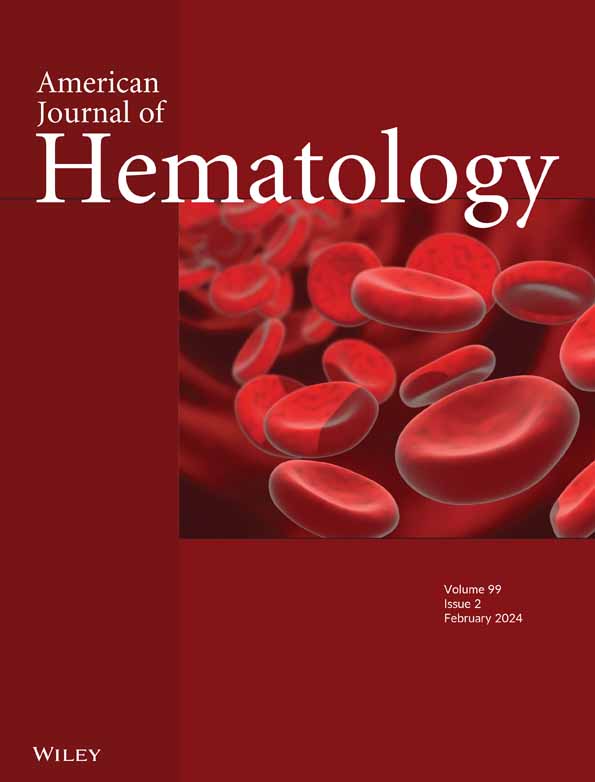Clinical Characteristics, Treatment Responses and Outcomes of Light Chain Multiple Myeloma
IF 9.9
1区 医学
Q1 HEMATOLOGY
引用次数: 0
Abstract
Light chain multiple myeloma (LCMM) is a subtype of multiple myeloma (MM) characterized by the exclusive production of immunoglobulin light chains and accounts for 15%–20% of newly diagnosed MM. A comprehensive comparison of LCMM with MM producing intact immunoglobulin (non‐LCMM) remains limited. In this retrospective study, we described distinct clinical and cytogenetic features and assessed long‐term outcomes in 852 LCMM patients diagnosed between 01/01/2004 and 12/31/2022, compared with non‐LCMM controls matched for age, sex, and year of diagnosis. On univariable analysis, LCMM patients were more likely to present with elevated creatinine (> 2 mg/dL), beta‐2‐microglobulin ≥ 5.5 mg/L, elevated LDH, hypercalcemia, t(11;14), del(13q), and t(6;14). Conversely, IMS‐IMWG high‐risk disease, hyperdiploidy, t(4;14), and serum albumin < 3.5 g/dL were less common. On multivariable analysis, elevated creatinine (OR: 5.1, 95% CI: 1.2–27,轻链多发性骨髓瘤的临床特点、治疗效果及预后
轻链多发性骨髓瘤(LCMM)是多发性骨髓瘤(MM)的一种亚型,其特征是只产生免疫球蛋白轻链,占新诊断的MM的15%-20%。LCMM与产生完整免疫球蛋白(非LCMM)的MM的综合比较仍然有限。在这项回顾性研究中,我们描述了2004年1月1日至2022年12月31日期间诊断的852例LCMM患者的独特临床和细胞遗传学特征,并评估了长期结果,与年龄、性别和诊断年份相匹配的非LCMM对照组进行了比较。单变量分析显示,LCMM患者更有可能出现肌酐升高(2 mg/dL)、β - 2 -微球蛋白≥5.5 mg/L、LDH升高、高钙血症、t(11;14)、del(13q)和t(6;14)。相反,IMS - IMWG高风险疾病、高二倍体、t(4;14)和血清白蛋白≥3.5 g/dL的发生率较低。在多变量分析中,肌酐升高(OR: 5.1, 95% CI: 1.2-27, p = 0.04)、t(11;14) (OR: 2.6, 95% CI: 1.3-5.2, p = 0.006)和del(13q) (OR: 4.1, 95% CI: 2.1-8.2, p = 0.001)与LCMM独立相关,而IMS - IMWG高风险疾病(OR: 0.3, 95% CI: 0.1-0.8, p = 0.02)和高二倍体(OR: 0.3, 95% CI: 0.1-0.7, p = 0.002)的发生率较低。尽管存在这些差异,一线治疗的LCMM和非LCMM患者的无进展生存期(HR: 0.97, 95% CI: 0.84-1.11, p = 0.63)和总生存期(HR: 0.99, 95% CI: 0.87-1.13, p = 0.94)相似。这项研究强调了LCMM独特的临床和细胞遗传学特征,其特点是肾衰竭、t(11;14)和del(13q)的发生率较高,IMS - IMWG高危疾病的患病率较低,生存结果可比较。
本文章由计算机程序翻译,如有差异,请以英文原文为准。
求助全文
约1分钟内获得全文
求助全文
来源期刊
CiteScore
15.70
自引率
3.90%
发文量
363
审稿时长
3-6 weeks
期刊介绍:
The American Journal of Hematology offers extensive coverage of experimental and clinical aspects of blood diseases in humans and animal models. The journal publishes original contributions in both non-malignant and malignant hematological diseases, encompassing clinical and basic studies in areas such as hemostasis, thrombosis, immunology, blood banking, and stem cell biology. Clinical translational reports highlighting innovative therapeutic approaches for the diagnosis and treatment of hematological diseases are actively encouraged.The American Journal of Hematology features regular original laboratory and clinical research articles, brief research reports, critical reviews, images in hematology, as well as letters and correspondence.

 求助内容:
求助内容: 应助结果提醒方式:
应助结果提醒方式:


